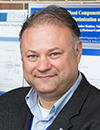08:00 | Conference Registration and Materials Pick-Up + Coffee in the Exhibit Hall |
09:00 |   | Conference Chair Welcome and Introduction by Conference Co-Chairpersons -- Scope of the Conference and Topics Covered
Albert Folch, Professor of Bioengineering, University of Washington
Sunitha Nagrath, Professor of Chemical Engineering and Biomedical Engineering, University of Michigan-Ann Arbor, United States of America
|
|
|
Session Title: 3D-Printing of Microfluidics |
| |
09:15 |  | Keynote Presentation High Resolution Negative Space 3D Printing for Microfluidics
Gregory Nordin, Professor, Brigham Young University, United States of America
While there is great interest in 3D printing for microfluidic device fabrication, a main challenge has been to achieve feature sizes that are in the truly microfluidic regime (<100 µm). A key issue is that microfluidic devices are comprised primarily of negative space features, which therefore dominate 3D printing resolution requirements, as compared to positive space features that are typical for many other 3D printing applications. Consequently, we have developed our own stereolithographic 3D printers and materials that are specifically tailored to meet these needs. We have shown 3D printed channels as small as 18 µm x 20 µm, and have recently reduced this to 2 µm x 2 µm. We have also developed active elements such as valves and pumps with the smallest valves having an active area of only 15 µm x 15 µm. In this presentation we discuss how such results are achieved and demonstrate miniaturized components including small (<1mm^3) fast (~1 ms) mixers and isoporous membranes with 7 µm pores. We also demonstrate integrated 3D printed devices such as for controllable cell chemotaxis. Advances in negative space 3D printing open the door to replacing expensive cleanroom fabrication processes with 3D printing, with the additional advantage of fast (~5-15 minute), parallel fabrication of many devices in a single print run due to their small size. |
|
10:00 |  | Keynote Presentation Modular Design Workflows for 3D Printed Microfluidics
Noah Malmstadt, Professor, Mork Family Dept. of Chemical Engineering & Materials Science, University of Southern California, United States of America
3D printing brings with it a plethora of advantages for microfluidic applications. Principle among these are rapid prototyping, iterative design, and the ability to avoid the cost and overhead of cleanrooms. However, there is also an inherent advantage in being able to design and build devices in a truly three-dimensional, rather than layer-by-layer, geometry. One simple domain in which the advantages of true 3D routing are clear is in mixing. Control over a 3D geometry allows for multiple complex mixing configurations--herringbones, relamination mixers, chaotic advection--to be trivially constructed and recombined.
We have used these principles of 3D design to construct devices and systems for bioanalytical assays, for manufacturing biomaterials, and for industrial-scale manufacturing of novel materials. This talk will examine all of these applications and the manner in which 3d-centric microfluidic design can enable them. |
|
10:30 | A High Resolution, SLA PDMS Resin and its Application in Microfluidic Organ Models
Joseph Potkay, Research Assistant Professor, University of Michigan, Clinical Research Engineer, VA Ann Arbor Healthcare System, United States of America
This presentation will cover our progress toward developing and characterizing a high resolution and biocompatible polydimethylsiloxane SLA 3D printing resin and its use to create various microfluidic structures including microfluidic artificial lungs. |
11:00 | Mid-Morning Coffee Break and Networking in the Exhibit Hall |
11:30 |  | Keynote Presentation Additive Manufacturing for Microfluidic and Wearable Sensor Systems
Bonnie Gray, Professor of Engineering Science, Simon Fraser University, Canada
We are surrounded by sensors in our daily lives. These (usually) small, inobtrusive devices constantly capture data about our environment, and what we see, hear, and do. Sensors form the foundation for analysis systems and are an integral part of every closed-form system. Many sensors seek to provide more continuity for health and well-being via constant monitoring of important health parameters. Similarly, other sensors seek to address the health of other systems, such as preventing failures in the power grid. Sensors as discrete components may be difficult to integrate into low-profile systems, such as textile-based systems, for development of smart clothing. These and other sensors systems could benefit from 3D printing or other additive manufacturing methods, via the integration of conventional printing materials with new functional (e.g., sensing or actuating) printed materials. Sensors could thus be easily tailored and printed to individual needs and more easily integrated with other printed components. This presentation focuses on development of wearable and other printed sensors that are designed directly on textiles, or fabricated using 3D printing methods for easier integration with fluidic housings. We discuss the current state-of-the-art, and present examples of integrated textile-based and printing-based sensors. We investigate how advances in flexible devices and systems (electronics, sensors, actuators, microfluidics) and additive manufacturing (e.g., printing) can be adapted to low-profile, non-obtrusive, and personalized sensor systems. |
|
12:00 |  | Keynote Presentation Integration and DFM for Microfluidics
Leanna Levine, Founder & CEO, ALine, Inc., United States of America
Most microfluidic cartridges require integration of mixed materials and components to create the complete functional product architecture. This talk will address the key considerations for DFX while leveraging a range of prototyping techniques including 3D printing, CNC machining, Injection molding and Laminate Fluid Circuit Technology, to position a product for transfer to scale up with high volume manufacturing techniques. |
|
12:30 | Networking Buffet Lunch in the Exhibit Hall -- Networking with Colleagues, Engage with Exhibitors and View Posters |
13:30 |  | Keynote Presentation Rapid Micromolding of Sub-100 Micron Microfluidic Devices Using an 8K Resin 3D Printer
Amar Basu, Professor, Electrical and Computer Engineering, Wayne State University, United States of America
Microfluidics relies on the ability to manufacture sub-100 micrometer fluidic channels. Conventional lithographic methods provide high resolution but have turnaround time of several days, while rapid prototyping methods (e.g., laser cutters, craft cutters, fused deposition modeling) have feature sizes of several hundred microns or more. This talk describes a single-day process for fabricating sub-100 µm channels, leveraging a low-cost 8K digital light projection (DLP) 3D resin printer. The process can create microchannels with 44 µm lateral resolution and 25 µm height, posts as small as 400 µm, aspect ratio up to 7, structures with varying z-height, integrated reservoirs for fluidic connections, and a built-in tray for casting. This talk will cover the key process steps (mold printing, post-treatment, and casting polydimethylsiloxane (PDMS) elastomer) and discusses strategies to obtain robust structures, prevent mold warpage, facilitate curing and removal of PDMS during molding, and recycle the solvents used in the process. This process provides a balance between resolution, turnaround time, and cost (~USD 5 for a 2 × 5 × 0.5 cm3 chip) that may be useful for many microfluidics labs. |
|
14:00 |  | Keynote Presentation 3D-Printed Microfluidic Circuitry via Alternative Additive Manufacturing Strategies
Ryan Sochol, Associate Professor, University of Maryland, College Park, United States of America
Over the past decade, researchers have demonstrated that additive manufacturing—or “three-dimensional (3D) printing”—approaches provide powerful means for achieving integrated microfluidic circuits and systems. Although the majority of developments in the area of 3D-printed microfluidic circuitry have relied on mesoscale “vat photopolymerization” techniques, such as “stereolithography”, there are a wide range of additive manufacturing approaches that offer utility for microfluidic circuit design, fabrication, and integration. In this talk, Prof. Ryan D. Sochol will discuss how his Bioinspired Advanced Manufacturing (BAM) Laboratory is leveraging the capabilities of alternative additive manufacturing technologies—namely “PolyJet 3D Printing” and “Two-Photon Direct Laser Writing”—to realize 3D-printed microfluidic circuits for soft robotic applications… including a soft robotic “hand” that plays Nintendo. |
|
14:30 | Antigen-Independent Single-Cell Phenotyping Using Biolasers
Xudong Fan, Richard A. Auhll Endowed Professor of Engineering and Professor, Biomedical Engineering , The University Of Michigan, United States of America
Weishu Wu, PhD Student of Xudong Fan, Richard A. Auhll Endowed Professor of Engineering, University of Michigan, United States of America
In this talk we will present our work on deep learning-assisted biolaser platform that examines the intracellular environment and is capable of performing cell classification without depending on labeling specific proteins on the cells. We verified our system on detecting circulating tumor cells from white blood cells (WBCs) with high accuracy. |
15:00 |  | Keynote Presentation Biochemical Assays in Variable Height Microfluidic Devices
Mark Burns, T. C. Chang Professor of Engineering, University of Michigan, United States of America
Processing of solid particles in 3D-printed fluidic channels has the potential to expand the application space of microfluidic systems. As an example, selective binding of proteins, DNA, and other biological substances is used in assays to detect pathogens, diagnose disease, and guide patient treatment. The capture of these substances can take place in a bulk liquid phase, which is generally simpler, or on a solid surface, which provides the benefit of straightforward two-dimensional result interpretation. We combine these two techniques to achieve the best of both worlds. We use an antibody sandwich assay with the capture antibody immobilized on the solid surface of microbeads, each of which has a specific diameter corresponding to one protein in a multiplexed adsorption assay. The beads are then introduced into a microfluidic channel with varying heights, allowing each bead size to become trapped at a distinct location. This method effectively transforms a three-dimensional suspension into a two-dimensional layout, simplifying the reading of binding results. The channel is currently constructed using a variable etch of a glass substrate in hydrofluoric acid but we hope to use other techniques such as 3D printing to produce these chips. One printing technique we have developed, dual-wavelength stereolithography, could eventually fulfill this goal but the current resolution is too low. |
|
15:30 |  ASIGA Advancing 3D Printed Microfluidics ASIGA Advancing 3D Printed Microfluidics
Cory Lambertson, General Manager Americas, ASIGA
ASIGA is a leader in reliable and precise DLP 3D Printers. In this talk we will show you how to leverage our open material system and voxel-level control over all parameters in our 3D printers to create cutting edge Microfluidic Chips.
|
16:00 | 3D-Printed Epidermal Microfluidic Systems
Tyler Ray, Professor, University of Hawaii at Manoa, United States of America
An emerging class of wearable devices integrates microfluidic lab-on-chip designs with low-modulus materials, colorimetric assays, and electrochemical sensors to support the real-time, non-invasive analysis of sweat. Such skin-interfaced microfluidic systems offer powerful capabilities for personalized assessment of health, nutrition, and wellness through the non-invasive, real-time analysis of sweat. Initially simple systems of microfluidic channels, current devices comprise sophisticated networks channels, valves, and reservoirs with some embodiments employing multilayer design strategies. While these platforms exhibit powerful analytical capabilities, device fabrication requires time, labor, and resource-intensive cleanroom processing, which restricts the device design space (2D) and elongates the development time. Additive manufacturing processes, particularly stereolithography (SLA)-based printing, offer powerful pathways for overcoming these limitations by providing significant reductions in prototype development cost and cycle time while substantially expanding device capabilities with fully 3D device designs. Here, we present a simplified 3D-printing prototyping process to fabricate flexible, stretchable, epidermal microfluidic devices (‘3D-epifluidics’). Reducing fabrication time to [O]min, this approach enables the integration of spatially-engineered features including 3D-structured passive capillary valves, monolithic channels, and reservoirs with spatially-graded geometries. With geometric features comparable to established epifluidic devices (channels >50 µm), benchtop and on-body testing validate the performance of 3D-epifluidic devices. |
16:30 |  | Keynote Presentation High-Throughput Lung Microphysiological Systems
Shuichi Takayama, Professor, Georgia Research Alliance Eminent Scholar, and Price Gilbert, Jr. Chair in Regenerative Engineering and Medicine Wallace H. Coulter Department of Biomedical Engineering, Georgia Institute of Technology & Emory University School of Medicine, United States of America
There is a need to better understand lung disease, accelerate drug discovery, and better predict human clinical trial outcomes and individualized drug responses. This presentation will describe efforts to develop microphysiological systems (MPSs) to accomplish this goal. Specific topics include the first microfluidic lung-on-a-chip developed at Michigan. A Transwell-96 based air-blood barriers that can be coupled with automated flow cytometry. And a 384 well format assay using lung Organoids with Reversed Biopolarity (lung-ORBs). Specific applications include single-ORB based high-throughput assays of SARS-CoV-2 infection and therapeutics, neutrophilic inflammation studies, and analyzing the injurious effects of fluid mechanical effects associated with lung stethoscope sounds. |
|
17:00 | Beer and Wine Reception for all Participants |
18:00 | Evening Offsite Reception Sponsored and Hosted by ASIGA -- Mexican Food, Beer, Wine and Networking at the ASIGA Laboratory in Ann Arbor, Michigan |
20:30 | Close of Day 1 of the Conference |















